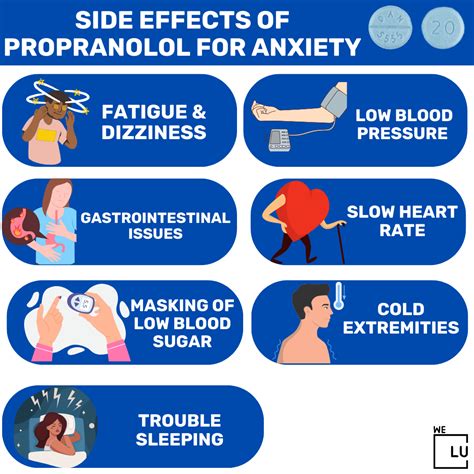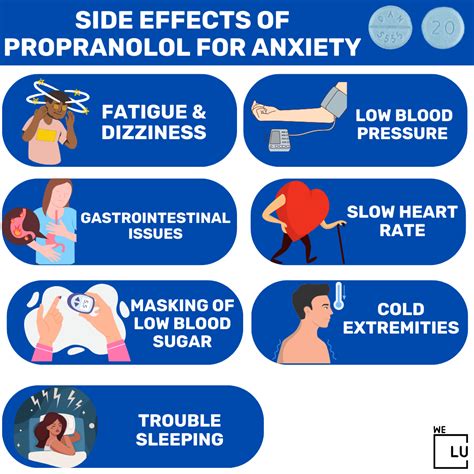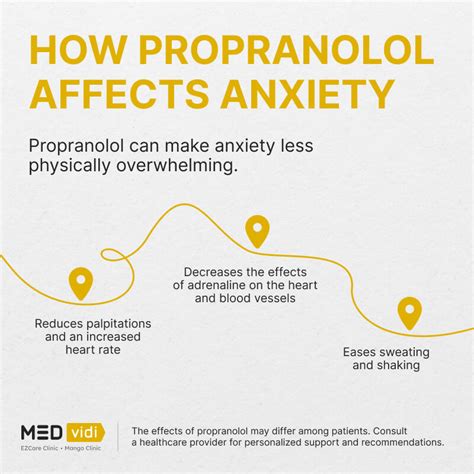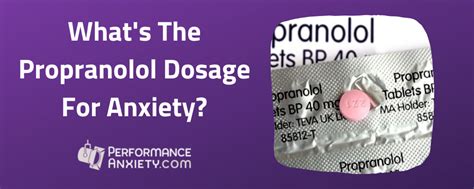Intro
Propranolol is a widely used medication that belongs to the class of beta-blockers. It is primarily prescribed to treat high blood pressure, angina, certain heart rhythm disorders, and other cardiovascular conditions. Additionally, propranolol is used to prevent migraine headaches, manage tremors, and alleviate symptoms of anxiety and performance anxiety. Despite its effectiveness, propranolol can cause a range of side effects, some of which can be severe and require medical attention.
The importance of understanding the potential side effects of propranolol cannot be overstated. Patients who are informed about the possible risks and benefits of their medication are better equipped to manage their condition and make informed decisions about their healthcare. Furthermore, recognizing the signs and symptoms of propranolol side effects can help individuals seek medical attention promptly, reducing the risk of complications and improving treatment outcomes.
Propranolol works by blocking the effects of epinephrine, also known as adrenaline, on the body's beta receptors. This action slows down the heart rate, reduces blood pressure, and decreases the force of the heart's contractions. While propranolol is generally well-tolerated, its impact on the body's physiological processes can lead to a range of side effects, from mild and temporary to severe and long-lasting. In the following sections, we will delve into the different types of side effects associated with propranolol, their causes, and management strategies.
Common Side Effects Of Propranolol

Propranolol can cause a variety of common side effects, including dizziness, lightheadedness, and fatigue. These symptoms are often related to the medication's effects on blood pressure and heart rate. Other common side effects of propranolol include nausea, vomiting, diarrhea, and constipation. In some cases, patients may experience changes in sleep patterns, such as insomnia or vivid dreams. Weight gain is also a possible side effect of propranolol, particularly if the medication causes increased appetite or water retention.
Causes Of Common Side Effects
The causes of common side effects of propranolol can be attributed to the medication's mechanism of action. By blocking beta receptors, propranolol reduces the body's "fight or flight" response, leading to decreased heart rate, blood pressure, and cardiac output. This can result in dizziness, lightheadedness, and fatigue, particularly when standing up or changing positions. Additionally, propranolol's effects on the gastrointestinal system can cause nausea, vomiting, and changes in bowel movements.Less Common Side Effects Of Propranolol

In addition to common side effects, propranolol can cause less common but potentially more serious side effects. These include shortness of breath, wheezing, and coughing, which can be indicative of bronchospasm or asthma exacerbation. Propranolol can also cause changes in liver function, leading to elevated liver enzymes and, in rare cases, liver failure. Other less common side effects of propranolol include Raynaud's phenomenon, which is characterized by cold hands and feet, and impotence or erectile dysfunction.
Management Of Less Common Side Effects
Managing less common side effects of propranolol often requires a combination of medical interventions and lifestyle modifications. For example, patients experiencing bronchospasm or asthma symptoms may need to use inhalers or adjust their asthma medication regimen. Those with liver function abnormalities may require regular monitoring of liver enzymes and adjustment of their propranolol dosage. In cases of Raynaud's phenomenon, patients can try lifestyle modifications such as avoiding cold temperatures, quitting smoking, and exercising regularly.Severe Side Effects Of Propranolol

While rare, propranolol can cause severe side effects that require immediate medical attention. These include anaphylaxis, a life-threatening allergic reaction characterized by difficulty breathing, rapid heartbeat, and a drop in blood pressure. Propranolol can also cause a severe decrease in blood pressure, leading to dizziness, fainting, and even organ failure. Other severe side effects of propranolol include heart block, which is a condition where the heart beats too slowly, and cardiogenic shock, a life-threatening condition where the heart is unable to pump enough blood to meet the body's needs.
Emergency Response To Severe Side Effects
In the event of severe side effects, it is essential to seek medical attention promptly. Patients experiencing anaphylaxis or severe allergic reactions should call emergency services or visit the nearest emergency room. Those with severe decreases in blood pressure or heart rate should lie down and elevate their legs to improve blood flow to the brain. In cases of heart block or cardiogenic shock, patients may require hospitalization and treatment with medications such as atropine or epinephrine.Special Considerations And Precautions

When taking propranolol, there are several special considerations and precautions to keep in mind. Patients with a history of asthma or chronic obstructive pulmonary disease (COPD) should use propranolol with caution, as it can exacerbate respiratory symptoms. Those with diabetes should monitor their blood sugar levels closely, as propranolol can mask symptoms of hypoglycemia. Pregnant or breastfeeding women should consult their healthcare provider before taking propranolol, as it can pass into breast milk and affect the baby.
Interactions With Other Medications
Propranolol can interact with a range of medications, including other beta-blockers, calcium channel blockers, and anti-arrhythmic medications. Patients taking these medications should inform their healthcare provider, as dosage adjustments may be necessary to avoid adverse interactions. Additionally, propranolol can interact with non-steroidal anti-inflammatory drugs (NSAIDs), which can increase the risk of bleeding and bruising.Long-Term Effects Of Propranolol

The long-term effects of propranolol can vary depending on the individual and the condition being treated. Some patients may experience a range of benefits, including reduced blood pressure, improved heart function, and decreased symptoms of anxiety and tremors. However, long-term use of propranolol can also lead to rebound hypertension, where blood pressure increases rapidly if the medication is stopped abruptly. Other long-term effects of propranolol include changes in lipid profiles, which can increase the risk of cardiovascular disease.
Withdrawal Symptoms And Rebound Effects
When stopping propranolol after long-term use, patients may experience withdrawal symptoms such as headaches, dizziness, and nausea. These symptoms can be managed by gradually tapering off the medication under the guidance of a healthcare provider. Rebound effects, such as rebound hypertension, can also occur if the medication is stopped abruptly. To minimize the risk of rebound effects, patients should work closely with their healthcare provider to develop a tapering schedule that suits their individual needs.Conclusion And Next Steps

In conclusion, propranolol is a widely used medication that can cause a range of side effects, from mild and temporary to severe and long-lasting. By understanding the potential risks and benefits of propranolol, patients can make informed decisions about their healthcare and work closely with their healthcare provider to manage their condition. If you are taking propranolol and experiencing side effects, it is essential to discuss your concerns with your healthcare provider, who can help you develop a treatment plan that minimizes risks and maximizes benefits.
We invite you to share your experiences and ask questions about propranolol and its side effects in the comments section below. Your feedback and insights can help others better understand the potential risks and benefits of this medication. Additionally, if you found this article informative and helpful, please consider sharing it with others who may benefit from this information.
What are the most common side effects of propranolol?
+The most common side effects of propranolol include dizziness, lightheadedness, fatigue, nausea, vomiting, diarrhea, and constipation.
Can propranolol cause severe side effects?
+Yes, propranolol can cause severe side effects, including anaphylaxis, severe decreases in blood pressure, heart block, and cardiogenic shock.
How can I minimize the risk of side effects when taking propranolol?
+To minimize the risk of side effects, it is essential to follow your healthcare provider's instructions, monitor your blood pressure and heart rate regularly, and report any concerns or side effects promptly.
